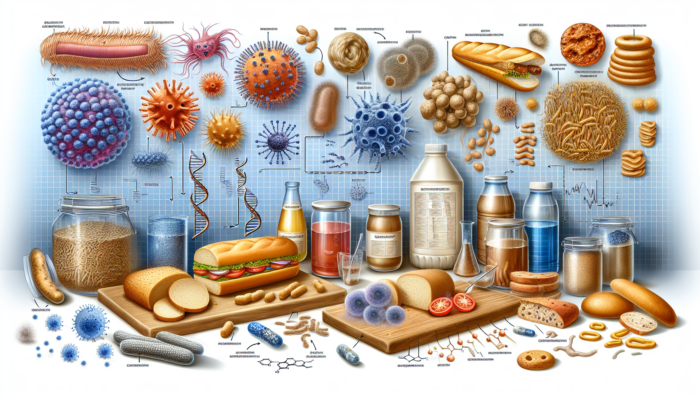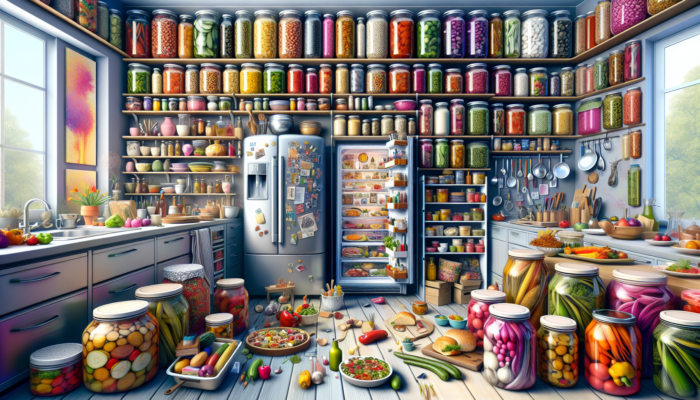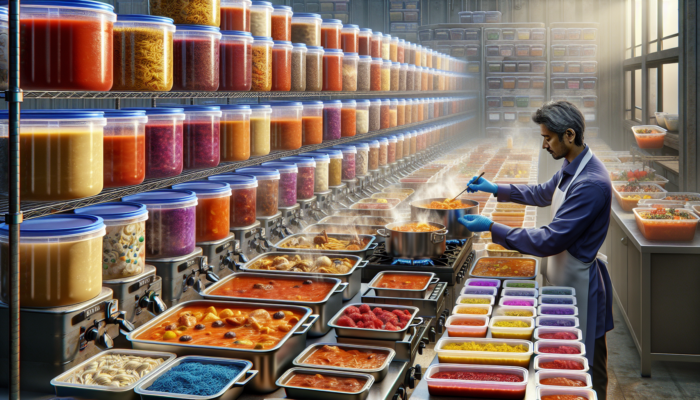Enhance Your Culinary Skills with Effective Food Preservation Techniques for Freshness and Flavor
Mastering food preservation techniques is not just a culinary skill; it’s a vital practice that promotes environmental sustainability and enhances your cooking experiences. By adopting these methods, you’ll indulge in delicious, vibrant flavors while reducing waste and environmental impact. This approach guarantees that your fresh greens maintain their vibrant color, and your leftovers are kept safe from spoilage. Let’s explore the essential foundations of retaining food freshness and flavor, beginning with a detailed look into the science of spoilage.
Discover the Science Behind Food Spoilage: Key Factors to Understand

Spoilage is an inevitable natural process that impacts all our beloved foods; however, equipping yourself with a solid understanding of its underlying science empowers you to effectively combat it. Three critical factors lead to food breakdown: microbial growth, enzymatic reactions, and oxidation. Microbial organisms such as bacteria, yeasts, and molds thrive in nutrient-rich environments, making even the most innocuous leftover pasta susceptible to deterioration. In essence, the combination of heat and moisture accelerates spoilage significantly.
Enzymatic activity is another crucial player in this narrative. Enzymes are natural proteins that facilitate the ripening process in fruits and vegetables. However, once the peak ripeness is achieved, these enzymes can lead to a decline in food quality. Additionally, oxidation refers to a chemical interaction between oxygen and food components, often resulting in fat rancidity and the browning of fruits, detracting from their visual appeal and taste.
By understanding these essential concepts, you can implement practical food preservation techniques that will significantly enhance the shelf life of your ingredients. Every proactive step, from managing moisture levels to utilizing airtight containers, contributes to maintaining freshness and flavor in your meals.
Optimize Your Food Storage: Ideal Temperature Settings for Refrigerators and Freezers
Temperature regulation is your most dependable ally in the ongoing battle against spoilage. Maintaining your refrigerator at a consistent temperature of approximately 4°C (39°F) is crucial for inhibiting microbial growth. Achieving this delicate balance is essential; an overly warm fridge invites bacterial growth, while a too-cold environment could freeze delicate herbs and other perishable items, compromising their quality.
For your freezer, aim for temperatures of -18°C (0°F) or lower. This temperature effectively halts microbial activity and preserves essential nutrients in your food. However, the manner in which you store food in these cold environments is equally important. Utilizing airtight containers or heavy-duty freezer bags is critical in preventing freezer burn, a notorious adversary that can significantly reduce both flavor and texture. Remember to label and date your frozen items, turning your freezer into an organized culinary time capsule instead of a chaotic abyss.
By mastering temperature management, you’ll not only extend the freshness of your food but also elevate the quality of your meals, ensuring that every dish is delicious and nutritious.
Master Humidity Control: Effective Strategies to Keep Your Produce Fresh and Crisp
Humidity is a key yet often underestimated factor in preserving the quality of your produce. The objective is to achieve the perfect balance between excessive dryness and excessive moisture. Elevated humidity levels can encourage mold growth, while insufficient humidity can lead to desiccation, resulting in fresh carrots turning into sad, shriveled sticks.
To manage humidity effectively, utilize your refrigerator’s crisper drawers, which are typically equipped with adjustable settings designed for this purpose. For leafy greens, wrapping them in a damp paper towel helps maintain moisture without creating a soggy environment. Additionally, consider investing in humidity-control packs or creating DIY solutions, such as placing a small bowl of water in your fridge to help regulate moisture levels.
It’s also wise to keep fruits separate from vegetables to minimize exposure to ethylene gas, which accelerates ripening and spoilage. Apples, bananas, and avocados are known ethylene producers, so it’s beneficial to designate a specific area for these fruits to prevent unintended spoilage.
By mastering humidity control, you’ll ensure that your produce remains vibrant and crisp, ready to enhance any dish with fresh and lively flavors.
Explore Innovative Food Preservation Strategies for Your Busy Lifestyle

In our fast-paced world, where time is often a luxury, innovative food preservation strategies can make all the difference between enjoying a home-cooked meal and resorting to inconvenient takeout options. Let’s explore some clever techniques tailored for busy families, ensuring you always have delicious, ready-to-eat meals without the hassle of last-minute cooking.
Quick Pickling: An Effortless and Flavorful Way to Preserve Vegetables
Quick pickling is a culinary technique that magically transforms ordinary vegetables into zesty delights. This method involves immersing vegetables in a solution made from vinegar, water, salt, and sugar, allowing them to absorb rich flavors while simultaneously extending their shelf life. The process is incredibly simple: slice your chosen vegetables, boil the pickling solution, and pour it over the veggies in a clean jar for preservation.
Homemade pickles can be enjoyed within just one day and can last for several weeks in the refrigerator. Vegetables such as cucumbers, carrots, or red onions are perfect for this method, adding a burst of flavor to salads, sandwiches, and charcuterie boards. This technique is a fantastic way to utilize wilting vegetables, preventing them from ending up in the compost bin.
Quick pickling not only infuses your meals with vibrant flavors but also sparks creativity in the kitchen. Feel free to experiment with various spices and herbs to customize your pickling solution, transforming your refrigerator into a treasure trove of tangy treats that enhance your culinary repertoire.
Prepare Freezer Meals for Streamlined Meal Planning and Convenience
Imagine coming home after a long day to find a delicious, home-cooked meal waiting for you. This is where freezer meals come into play, serving as the ultimate time-saving solution for busy households. By dedicating just a few hours to meal preparation, you can batch-cook and freeze wholesome meals that are ready to reheat whenever hunger strikes.
Begin by selecting recipes that freeze exceptionally well, such as casseroles, soups, and stews. Cook in bulk, portion the meals into freezer-friendly containers, and label them with the date and contents for easy access. When hunger calls, simply grab a meal from the freezer, pop it into the microwave or oven, and voilà—dinner is served without the fuss!
This strategy not only saves valuable time but also minimizes food waste—no more half-used ingredients languishing at the back of your refrigerator. Plus, knowing that a hearty, home-cooked meal is just minutes away makes it easier to resist the temptation of takeout.
Batch Cooking: Effectively Preparing Large Quantities for Future Enjoyment

Batch cooking is the superhero of meal preparation, allowing you to prepare large quantities of food in a single session. This method is efficient, economical, and an excellent way to ensure you always have nutritious meals readily available for your family.
Start by selecting recipes that are well-suited for batch cooking—think hearty stews, flavorful pasta sauces, and vibrant stir-fries. Dedicate time on the weekend to cook in bulk, portioning your creations into airtight containers, and storing them in the refrigerator or freezer for easy access later.
This approach simplifies your weekday meal prep and helps manage portion sizes, fostering healthier eating habits. Furthermore, it encourages culinary creativity—mix and match ingredients to keep your meals exciting, ensuring you never tire of the same offerings.
Batch cooking embodies the essence of food preservation techniques, transforming your kitchen into a sanctuary of convenience and flavor that aligns with your busy lifestyle.
Comprehensive Guide to Food Preservation Techniques: Embrace Natural Methods for Waste Reduction
As we navigate the complexities of contemporary life, adopting natural methods of food preservation becomes an indispensable practice. With sustainability at the forefront, let’s examine three powerful techniques designed to minimize waste while enhancing the flavors of your food.
Fermentation: Unlocking the Power of Beneficial Bacteria for Food Preservation
Fermentation is a time-honored technique that not only preserves food but also enhances its nutritional content. By harnessing the power of beneficial bacteria, you can create probiotic-rich foods that promote gut health while extending shelf life.
The fermentation process commences by introducing beneficial bacteria to your food, often through a starter culture or naturally occurring microbes. Commonly fermented foods include sauerkraut, kimchi, and yogurt. The magic occurs as these bacteria consume sugars and produce lactic acid, creating an environment where harmful bacteria cannot thrive.
Fermentation is accessible and requires minimal ingredients and equipment. Simply chop your vegetables, mix them with salt, and allow them to ferment in a clean jar. The end result? A tangy, flavorful product that can last for months in your refrigerator—delicious on its own or as a complement to a variety of dishes.
Dehydration: A Simple and Effective Method for Preserving Fruits, Vegetables, and Herbs Without Additives
Dehydration is a straightforward technique that preserves food while retaining its flavor and nutritional benefits. By removing moisture, you effectively inhibit the growth of spoilage-causing microorganisms, allowing you to enjoy seasonal produce long after the harvest has ended.
You can dehydrate food using a dehydrator, an oven, or by air-drying herbs. Slice fruits and vegetables evenly to ensure consistent drying. For herbs, gather them in bunches and hang them in a warm, dry location. The outcome is concentrated flavors that can be utilized in cooking, snacking, or as flavorful garnishes in your culinary creations.
Not only does dehydration extend shelf life, but it also significantly reduces food waste. Imagine transforming an abundance of apples into delightful dried chips or overripe tomatoes into delicious sun-dried delicacies. The possibilities are truly limitless!
Canning: A Time-Honored Technique for Long-Term Food Storage
Canning is a traditional preservation method that has stood the test of time. This technique involves sealing food in airtight jars and heating them to eliminate the bacteria and enzymes that cause spoilage, ensuring that your food remains fresh and safe for consumption.
It is essential to adhere to proper safety protocols while canning fruits, vegetables, or sauces to prevent health risks. Invest in quality canners and jars, ensuring they are thoroughly sterilized before use. The beauty of canning lies in its versatility; you can enjoy the bounty of your garden throughout the year, transforming seasonal produce into delectable preserves.
From homemade jams to pickled vegetables, the satisfaction of opening a jar of your creation during the winter months is unparalleled. Canning not only extends the shelf life of your food but also celebrates the joy of home cooking, allowing you to savor the flavors of each season long after they have passed.
Explore Modern Food Preservation Techniques: Utilizing Technology and Gadgets
Modern tools can revolutionize the way we preserve food in our tech-savvy world. With innovative gadgets at our disposal, let’s explore how technology enhances food preservation techniques for the contemporary kitchen.
Vacuum Sealing: Effortlessly Extend the Shelf Life of Your Food
Vacuum sealing is a groundbreaking method for food preservation. By removing air from bags or containers, you significantly reduce the risk of spoilage, keeping your food fresh for a much longer period.
This technique is particularly effective for meats, cheeses, and dry goods. Simply place your food in a vacuum-sealable bag, utilize the vacuum sealer to extract the air, and seal it shut. The result is an airtight environment that inhibits bacterial growth and oxidation, allowing your food to maintain its quality.
Vacuum-sealed food can remain fresh up to five times longer than traditionally stored items. Moreover, it’s incredibly versatile; use it for marinating meats, sous vide cooking, or storing bulk items efficiently. Embrace vacuum sealing to elevate your food storage practices to unprecedented heights.
Smart Refrigerators: Advanced Technology for Monitoring and Preserving Your Food
Welcome to the forefront of food preservation: smart refrigerators! These advanced appliances come equipped with features that enable you to monitor your food inventory, track expiration dates, and even suggest recipes based on the ingredients you have at home.
Imagine receiving notifications on your smartphone when your milk is nearing its expiration date or when it’s time to use that leftover roast. Smart refrigerators are designed to minimize food waste and ensure you utilize your ingredients as efficiently as possible.
Some smart refrigerators even allow remote control of temperature and humidity settings, ensuring optimal conditions for preserving your food. With these innovations, your refrigerator can become a proactive partner in your culinary adventures.
Sous Vide Cooking: A Precise Technique for Maintaining Meal Quality
Sous vide cooking is a precise method that involves sealing food in vacuum-sealed bags and cooking it in a water bath at a controlled temperature. This technique not only maintains the quality of your ingredients but also locks in flavors while ensuring even cooking throughout your meals.
The sous vide method enhances the taste and texture of your dishes while prolonging their shelf life. Cooking in a vacuum-sealed environment minimizes exposure to air, which reduces the risk of spoilage and degradation.
Sous vide is perfect for meal prep; you can cook and freeze large batches for future enjoyment. When you’re ready to eat, simply reheat your sous vide meal, and you’ll enjoy restaurant-quality dishes right at home without the fuss.
Embracing sous vide cooking offers a culinary time machine, allowing you to preserve the quality of your meals while effortlessly indulging in gourmet flavors.
Essential Food Preservation Techniques for Eco-Conscious Consumers
As awareness of environmental concerns continues to rise, sustainable practices in food preservation have become paramount. Let’s delve into practical strategies that minimize food waste and contribute to a healthier planet.
Effective Strategies for Minimizing Food Waste and Reducing Your Environmental Footprint
Minimizing food waste is a crucial aspect of sustainable living. One of the most effective strategies is to meticulously plan your meals. Create a shopping list based on your needs and adhere strictly to it to avoid impulse purchases that could lead to waste.
Additionally, get creative with repurposing your leftovers. Transform yesterday’s roast into a hearty, nutritious soup or use stale bread to whip up crispy croutons. By embracing innovative cooking techniques, you’ll discover countless ways to utilize what you have before it spoils.
Educating yourself on proper food storage methods is equally important. Understanding the best techniques for storing fruits, vegetables, and leftovers can significantly enhance their shelf life and reduce waste.
Implementing these strategies will not only lessen your environmental impact but also foster a more mindful approach to food consumption that benefits both you and the planet.
Composting: Converting Food Scraps into Nutrient-Rich Soil for Your Garden
Composting is an excellent way to transform food scraps into nutrient-rich soil, effectively closing the loop on food waste. By composting, organic waste is diverted from landfills, where it would otherwise contribute to harmful greenhouse gas emissions that threaten our environment.
Begin by establishing a compost bin in your garden or kitchen. Collect vegetable peels, coffee grounds, eggshells, and other organic materials. Layer them with browns, such as dried leaves and cardboard, to create a balanced compost mixture that promotes effective decomposition.
Over time, these scraps will break down into rich, dark compost that can nourish your garden. Composting not only reduces waste but also enhances soil quality, promoting healthy plant growth and minimizing the need for chemical fertilizers. Embrace composting as a sustainable practice that benefits both your kitchen and your garden, creating a beautiful cycle of nourishment.
Upcycling: Creative Methods to Repurpose Leftover Ingredients and Minimize Waste
Upcycling is the art of transforming leftover ingredients into something new and exciting. Instead of discarding those wilting greens or overripe bananas, unleash your creativity and see what you can create!
For example, turn stale bread into breadcrumbs or croutons. Use vegetable scraps to create a flavorful broth, or blend overripe fruits into refreshing smoothies. The possibilities are endless when you cultivate a creative mindset in the kitchen.
Moreover, consider incorporating this philosophy into your cooking routine. Plan meals that consciously use up ingredients that are nearing their expiration dates, ensuring that nothing goes to waste while delighting your palate with delicious dishes.
By prioritizing upcycling, you foster a sustainable kitchen that celebrates resourcefulness, creativity, and deliciousness, reducing your overall environmental impact.
Tailored Food Preservation Techniques for Different Food Types: Customized Solutions for Your Kitchen
Every food type possesses unique characteristics that affect preservation strategies. Understanding these nuances can help you tailor your techniques for maximum effectiveness. Let’s explore how to preserve specific food types with targeted preservation techniques.
Preserving Fresh Herbs: Effective Techniques for Maintaining Vibrancy and Flavor
Fresh herbs can elevate any dish, but they often wilt before you can fully appreciate their potential. Consider several effective techniques to preserve the vibrancy and flavor of your herbs, ensuring they remain a staple in your cooking.
One popular method involves freezing herbs in olive oil. Chop your fresh herbs, mix them with olive oil, and pour the mixture into ice cube trays. Once frozen, transfer the cubes to a freezer bag for convenient access. These flavor-packed cubes can be added directly to soups, stews, or sauces, infusing your dishes with fresh herb goodness.
Alternatively, you can dry herbs by hanging them upside down in a well-ventilated area. Once dried, store them in airtight jars to preserve their flavor for months, allowing you to enjoy their benefits long after the harvest.
By mastering the art of herb preservation, you’ll always have fresh, vibrant flavors at your fingertips, enhancing your culinary creations and ensuring that every meal is a delight.
Prolonging the Shelf Life of Dairy Products: Practical Tips for Storing Milk, Cheese, and Yogurt
Dairy products can present challenges when it comes to preservation, but with a few simple hacks, you can significantly extend their shelf life and maintain freshness. To ensure the longevity of milk, always store it in the coldest section of your fridge, ideally at the back, where temperatures remain most consistent.
For cheese, it’s beneficial to wrap it in parchment paper before placing it in an airtight container. This method allows the cheese to breathe while preventing it from drying out. For softer cheeses, consider adding a small piece of wax paper to absorb excess moisture and maintain texture.
Yogurt can also be preserved effectively by ensuring the lid is tightly sealed and storing it away from strong-smelling foods to protect its delicate flavor and quality.
Implementing these tips will ensure your dairy products remain fresh and enjoyable for longer, reducing waste and enhancing the overall quality of your meals.
Preserving Bread and Baked Goods: Techniques to Keep Your Baked Treats Fresh and Delicious
Bread and baked goods can quickly become stale, but utilizing the right preservation techniques can help keep them fresh and delicious. To maintain its crusty exterior, store bread in a paper bag at room temperature for short-term storage, allowing it to breathe while preventing moisture buildup.
For longer storage, freezing is your best option. Slice the loaf before freezing, enabling you to pull out individual slices as needed. Wrap the bread tightly in plastic or foil, then place it in a freezer bag to prevent freezer burn. When you’re ready to enjoy, simply toast or thaw at room temperature for freshness.
Baked goods like cookies or cakes should be stored in an airtight container to retain moisture. If they are frosted, consider refrigerating them to prevent melting and maintain their presentation.
By mastering these preservation techniques, you can savor your favorite baked treats without worrying about them going stale or losing their delightful flavors.
Your Questions Answered: Frequently Asked Questions About Food Preservation Techniques
What is the Recommended Safe Storage Duration for Different Types of Food?
The duration of safe storage varies by food type. Generally, most meats can be frozen for 6-12 months, while fruits and vegetables typically last around 8-12 months in the freezer. Always consult specific guidelines for each food type to ensure optimal safety.
What Are the Common Signs of Spoilage, and How Can I Prevent Foodborne Illness?
Common indicators of spoilage include off smells, changes in texture, and visible mold. Practicing proper food storage, hygiene, and cooking techniques are vital for preventing foodborne illnesses and maintaining food safety.
Can I Combine Different Preservation Methods for Enhanced Results?
Absolutely! Combining various preservation methods can enhance the overall effectiveness of your food storage. For instance, pickling vegetables followed by vacuum sealing can extend their shelf life while adding exciting flavors.
How Can I Determine If My Canning Process Was Successful?
A sealed lid that doesn’t pop when pressed indicates a successful canning process. If the lid flexes or pops, the jar may not be adequately sealed and should be refrigerated and consumed promptly.
Is it Possible to Freeze Leftover Canned Food?
Yes, you can freeze leftover canned food. Transfer the contents to an airtight container before freezing to prevent freezer burn and preserve quality.
What is the Best Method for Storing Leftover Takeaway Food?
Store leftover takeaway food in airtight containers in the refrigerator. For optimal food safety and quality, consume within 3-4 days to avoid spoilage.
Can I Preserve Cooked Food, and How Long Does It Last?
Yes, cooked food can be preserved by refrigerating or freezing it. In the fridge, it generally lasts 3-4 days; in the freezer, it can last 2-6 months depending on the type of food and storage conditions.
Is It Safe to Consume Food Past Its Expiration Date?
Not all foods are unsafe past their expiration date. Always check for signs of spoilage; if the food looks and smells fine, it may still be safe to consume within a reasonable timeframe.
How Can I Tell If My Food Has Experienced Freezer Burn?
Dry, discolored patches on food are indicative of freezer burn. While the food remains safe to eat, the affected areas may have a stale taste and texture that could detract from your meal.
What Should I Do with Food That Has Spoiled?
Dispose of any spoiled food immediately to prevent contamination of other food items. Composting is an eco-friendly option for dealing with organic waste.
Explore our world on X!
The post Food Preservation Techniques: Discover Revolutionary Hacks appeared first on Survival Bite.
The Article Food Preservation Techniques: Explore Innovative Hacks Was Found On https://limitsofstrategy.com


The exploration of food preservation techniques truly resonates with me, especially in an age where sustainability and reducing waste are increasingly pressing concerns. It’s fascinating to consider how mastering these methods not only lets us enjoy seasonal produce year-round but also allows us to minimize our environmental footprint. I’ve recently started experimenting with fermentation—a method steeped in tradition that taps into natural microbial processes to create both flavor and longevity.
I can relate to what you’re saying about the exploration of food preservation techniques. In today’s context, where sustainability is so crucial, it’s amazing how traditional methods like fermentation can provide both practical benefits and a deeper connection to food. It sounds like you’re really diving into it—fermentation has such a rich history across different cultures, from kimchi in Korea to sauerkraut in Germany.
You’re touching on something really important. The revival of traditional food preservation techniques like fermentation does offer us a chance to rethink our relationship with food. It’s fascinating how these methods not only help us extend the life of our ingredients but also enrich our culinary experiences.
“I’m glad to hear you resonate with the exploration of fermentation! If you’re interested in diving deeper into these fascinating techniques and their cultural significance, check out this resource that delves into the art of preserving food sustainably.”
https://martharoseboutique.co.uk/trustindex
I agree; it’s fascinating how food preservation techniques like fermentation bridge our past and present. There’s something incredibly grounding about using methods that have been passed down through generations. I’ve recently been experimenting with making my own kombucha, and it’s been a fun challenge to learn the balance of flavors and the fermentation process itself.
It’s interesting to hear about your kombucha journey. Fermentation does have that unique blend of science and art, doesn’t it? One thing I’ve noticed while exploring different methods is how easily things can go off track if you don’t pay attention to the details—timing, temperature, and even the balance of ingredients can really make or break the batch. Have you run into any unexpected flavors or challenges during your fermentation experiments? It can be a real lesson in patience and observation, bringing a deeper appreciation for how our ancestors must have navigated these processes without the conveniences we have today. Would love to know what flavors you’re leaning toward!
“I’m glad to hear you’re diving into kombucha! If you’re interested in exploring more about fermentation and its rich history, check out this resource that delves deeper into these time-honored techniques.”
https://martharoseboutique.co.uk/eComToolkit
It’s great to hear that you’re diving into food preservation, especially with fermentation! There’s something really special about how these age-old techniques connect us to our food and the environment. By harnessing natural microbial processes, you’re not just making food last longer; you’re also creating unique flavors that can transform a dish.
“I’m so glad to hear you’re exploring fermentation! If you’re looking for more insights and techniques to enhance your food preservation journey, check out this resource—it might spark some new ideas for your culinary adventures!”
https://martharoseboutique.co.uk/quillbot
Your insights on food preservation techniques are both enlightening and timely, particularly as we navigate the complexities of food waste and sustainability. Personally, I’ve always been fascinated by the intersection of culinary art and science, especially when it comes to understanding spoilage mechanisms.
It’s great to hear your interest in the blend of culinary art and science—it’s a fascinating area that influences so much of what we eat. Understanding spoilage mechanisms goes beyond just preventing waste; it helps us appreciate flavors, textures, and even the nutritional profiles of our food. For instance, did you know that certain bacteria can enhance the taste of fermented foods while others lead to spoilage? This balancing act between safety and flavor is a key part of food preservation.
It’s refreshing to see someone who shares a genuine curiosity about the relationship between culinary art and the science of food preservation. Your interest in spoilage mechanisms opens up a broader conversation about how we interact with food at every level—from the farm to our kitchens.